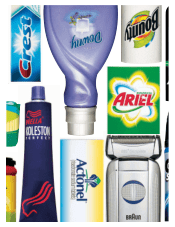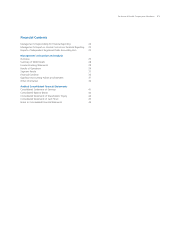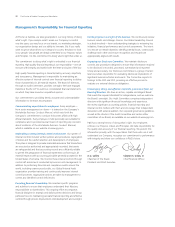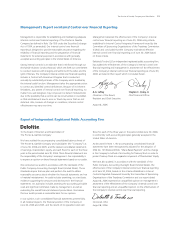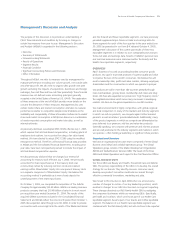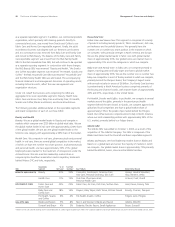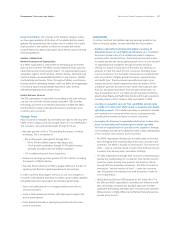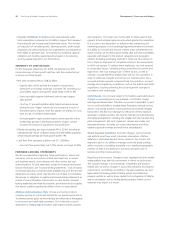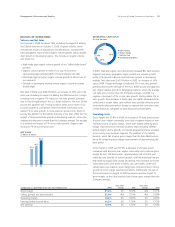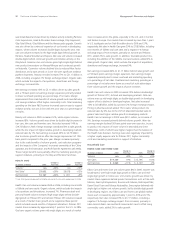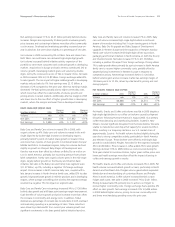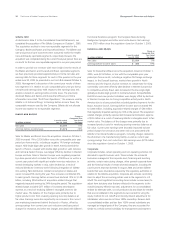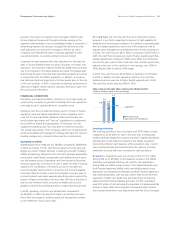Proctor and Gamble 2006 Annual Report Download - page 27
Download and view the complete annual report
Please find page 27 of the 2006 Proctor and Gamble annual report below. You can navigate through the pages in the report by either clicking on the pages listed below, or by using the keyword search tool below to find specific information within the annual report.The Procter &Gamble Company and Subsidiaries 25
Management’s Discussion and Analysis
The purpose of this discussion is to provide an understanding of
P&G’s financial results and condition by focusing on changes in
certain key measures from year to year. Management’s Discussion
and Analysis (MD&A) is organized in the following sections:
•Overview
•Summary of 2006 Results
•Forward-Looking Statements
•Results of Operations
•Segment Results
•Financial Condition
•Significant Accounting Policies and Estimates
•Other Information
Throughout MD&A, we refer to measures used by management to
evaluate performance including unit volume growth, net outside sales
and after-tax profit. We also refer to organic sales growth (net sales
growth excluding the impacts of acquisitions, divestitures and foreign
exchange), free cash flow and free cash flow productivity. These financial
measures are not defined under accounting principles generally
accepted in the United States of America (U.S. GAAP). The explanation
of these measures at the end of MD&Aprovidesmoredetailsonthe
use and the derivation of these measures. Management also uses
certain market share and market consumption estimates to evaluate
performance relative to competition despite some limitations on the
availability and comparability of share information. References to market
share and market consumption in MD&A are based on a combination
of vendor-reported consumption and market size data, as well as
internal estimates.
As previously disclosed, we adopted SFAS 123(R) effective July 1, 2005,
which requires that all stock-based compensation, including grants of
employee stock options, be accounted for using a fair value-based
method. We have elected to adopt SFAS 123(R) using the modified
retrospective method. Therefore, all historical financial data provided
in MD&A and the Consolidated Financial Statements, including prior
year data, have been retrospectively revised to include the impact of
all stock-based compensation expense.
We also previously disclosed that we changed our method of
accounting for treasury stock effective July 1, 2005. We previously
accounted for share repurchases as if the treasury stock was
constructively retired by reducing common stock and retained
earnings within Shareholders’ Equity. We now present treasury stock
as a separate component of Shareholders’ Equity. We believe this
accounting method is preferable as it more closely depicts the
underlying intent of the share repurchases.
On October 1, 2005, we completed the acquisition of The Gillette
Company for approximately $53.43 billion. Gillette is a leading consumer
products company that had $10.48 billion of sales in its most recent
pre-acquisition year ended December 31, 2004. The results of the
acquired Gillette businesses included in the Consolidated Financial
Statements and MD&A reflect the nine-month period from October 1,
2005 (the acquisition date) through June 30, 2006. In order to provide
our investors with more insight into the results of the Blades and Razors
and the Duracell and Braun reportable segments, we have previously
provided supplemental pro forma net sales and earnings data for
these segments for each of the four quarters in the year ended June
30, 2005 (as presented in our Form 8-K released October 4, 2005).
Management’s discussion of the current year results of these two
reportable segments is in relation to such comparable prior year pro
forma net sales and earnings data. Results of Gillette’s personal care
and oral care businesses were subsumed within the Beauty and the
Health Care reportable segments, respectively.
OVERVIEW
P&G’s business is focused on providing branded consumer goods
products. Our goal is to provide products of superior quality and value
to improve the lives of the world‘s consumers. We believe this will
result in leadership sales, profits and value creation, allowing employees,
shareholders and the communities in which we operate to prosper.
Our products are sold in more than 180 countries primarily through
mass merchandisers, grocery stores, membership club stores and drug
stores. We have also expanded our presence in “high frequency stores,”
the neighborhood stores which serve many consumers in developing
markets. We have on-the-ground operations in over 80 countries.
Our market environment is highly competitive, with global, regional
and local competitors. In many of the markets and industry segments
in which we sell our products, we compete against other branded
products as well as retailers’ private-label brands. Additionally, many
of the product segments in which we compete are differentiated by
price (referred to as premium, mid-tier and value-tier products).
Generally speaking, we compete with premium and mid-tier products
and are well positioned in the industry segments and markets in which
we operate— often holding a leadership or significant share position.
Organizational Structure
We have an organizational structure that is comprised of three Global
Business Units (GBUs) and a Global Operations group. The Global
Operations group consists of the Market Development Organization
(MDO) and Global Business Services (GBS). The heads of the three
GBUs and Global Operations each report to the Chief Executive Officer.
GLOBAL BUSINESS UNITS
Our three GBUs are Beauty and Health, Household Care and Gillette
GBU. The primary responsibility of the GBUs is to develop the overall
strategy for our brands. They identify common consumer needs,
develop new product innovations and build our brands through
effective commercial innovations, marketing and sales.
We moved to this structure in April 2006 when we announced a
number of changes to certain of our key leadership positions, which
resulted in changes to our GBU structure and our segment reporting.
These changes dissolved our P&G Family Health GBU by realigning
the component businesses within our remaining GBUs. Specifically,
pet health and nutrition, which used to be part of our Health Care
reportable segment, became part of our Snacks and Coffee reportable
segment. The balance of our Health Care reportable segment was
combined with the P&G Beauty GBU, but will continue to be reported





